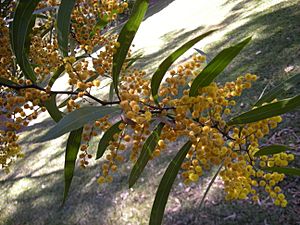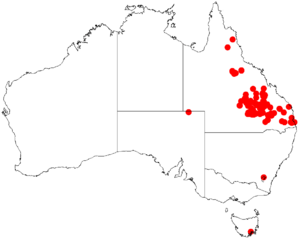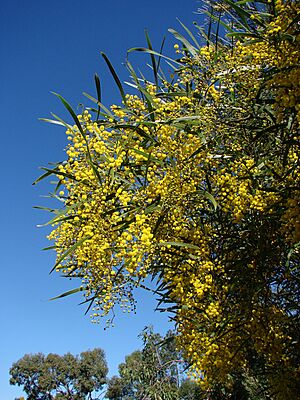Acacia macradenia facts for kids
Quick facts for kids Acacia macradenia |
|
|---|---|
 |
|
| Scientific classification | |
| Genus: |
Acacia
|
| Species: |
macradenia
|
 |
|
| Occurrence data from AVH | |
| Synonyms | |
|
Racosperma macradenium (Benth.) Pedley |
|
Acacia macradenia is a type of wattle plant. It is also known as the zig-zag wattle. This name comes from its zig-zag shaped stems. People sometimes call it the 'bed of rivers' too.
You can spot this plant by its unique features. It has leaves that grow in an alternating pattern. It also has bright yellow, round flower clusters. These clusters grow where the branches fork.
Contents
What's in a Name? (Taxonomy)
The plant Acacia macradenia was first described in 1848. This was done by a scientist named George Bentham. The plant still has the same name today.
Its name comes from Ancient Greek words. Macros means "long," and adenos means "gland."
Sometimes, Acacia macradenia can mix with other wattle plants. For example, it has mixed with A. bancroftiorum in nature. The new plants look a bit like A. holotricha. It has also mixed with the fringed wattle (A. fimbriata) when grown by people.
Where Does It Grow? (Distribution)
Acacia macradenia is originally from Australia. It grows naturally across Central Queensland. You can also find it growing in areas like Chinchilla and Pentland.
This plant can spread easily. Because of this, it has been seen in parks outside its natural home. For example, it has been found in Ipswich.
Home and Habits (Habitat and Ecology)
The zig-zag wattle is a shrub. It likes to grow in cool to warm places. It prefers sandy or gravelly areas near creeks. Cold weather helps its seeds grow stronger flowers later. This happens when the temperature gets warmer.
Acacia macradenia can even grow in places with air pollution. Scientists did an experiment. They put Acacia macradenia seeds in different polluted areas. The plants still grew well. Their ability to make food and release water stayed normal.
What Does It Look Like? (Description)
The branches of Acacia macradenia are smooth. They do not have any hair. Younger stems are usually green. Older parts of the stem turn brown.
The parts that look like leaves are called phyllodes. These are actually flattened leaf-stalks. They are also known as petioles. At first, they have a special bipinnate shape. Older phyllodes are darker and longer. They have a lanceolate shape. Younger phyllodes are much smaller.
This plant can grow quite tall. It can reach up to 5 meters (about 16 feet) high. It can also spread out 4 meters (about 13 feet) wide. Its branches hang down loosely. They can also bend easily.
Small, yellow, round flower clusters grow on the stems. Each cluster has many tiny flowers. There can be between 35 and 50 flowers in one cluster. Each flower has five petals and sepals. They also have many stamens. This makes the clusters look soft when they are fully open.
When these flowers bloom depends on the weather. They flower best in February and March. If new growth appears, it might look reddish. If no flower clusters grow, the phyllodes will keep growing in an alternating pattern.
The fruits of the zig-zag wattle are black pods. They look a bit like lima beans. These pods are small and curved. They have a smooth outside. At first, the pods are green. They turn brown-black as the weather gets warmer in spring. They can grow up to 12 cm (about 5 inches) long when fully grown. Inside these pods are hard, brown, bean-shaped seeds.
An experiment showed something interesting about the seeds. Seeds treated with hot water grew better. They germinated more easily than seeds treated with cooler water.
How Does It Spread? (Dispersal)
Acacia macradenia seeds spread naturally. Birds, ants, and other animals help move them around. However, humans are the biggest reason they spread. People plant them for different reasons.
They are used to help areas grow plants again. They are also planted because they look nice. People like their "unusual architecture and striking floral displays."
Because its seeds spread so well, A. macradenia can be an invasive species. This means it can take over new areas in Australia. It can dominate these places. There are no laws in Australia to stop its spread. The hard shells of its seeds help it survive. This allows it to outgrow other Acacia species in Australia.
Growing This Plant (Cultivation)
Acacia macradenia likes soil that drains well. It grows best in full sun. It has been grown successfully in coastal areas. These areas are in eastern Australia. They stretch from Townsville down to Melbourne.
However, this plant does not do well with heavy frosts. In some inland places, like Canberra, plants have died from cold.
Images for kids




